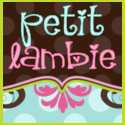Gather your supplies. You will need:
*A bib that currently fits your toddler
*Fabric for the front and back of the bib
For the front of my bibs, I used 3 fat quarters from Robert Kaufman's Airplanes, trains, and cars collection. The colors and designs are darling and totally boy, plus the fabric is 100% organic cotton (so be sure you wash it before you cut and sew it). I used plain white cotton flannel for the back of my bibs.
*Newspaper or other large sheet of paper
*Velcro
*Scissors, matching thread, pins, a pencil, and a sewing machine.
Since I didn't have a pattern for a bib, I made my own simply by tracing the Halloween one I already had onto a page from the newspaper. When you trace your bib, be sure that you add 1/4 of an inch to the outside edges of the bib so that you have a seam allowance when you go to sew it together. If you forget to add the seam allowance, your bib may turn out smaller than you want.
After your pattern is made, pin it to your fabric and cut it out.
 |
| Cutting out the back and the front |
You can probably cut the back and the front out at the same time if you want to. I cut them separately when I made my first bib. Since I was making three bibs in one day, I found it faster to cut everything out at the same time & didn't notice that it made much of a difference in the size or pattern of each peice.
Before you put the right sides of the front and back peices together, you need to pin the velcro on. It will go in the upper right hand corner on the right side of each peice.
 |
| This is where the velcro should be when you're finished. I had to use two strips of velcro to get the width I wanted. There was a very limited selection at my local hobby store. I will try harder to find wider velcro in the future. This works in a pinch, though.
After you have your velcro pinned where it belongs you can put the right sides of the front and back peices together, pin them in place, and then sew. Make sure you leave 2" opening along the bottom edge so you can turn your bib right side out.
|













0 comments:
Post a Comment